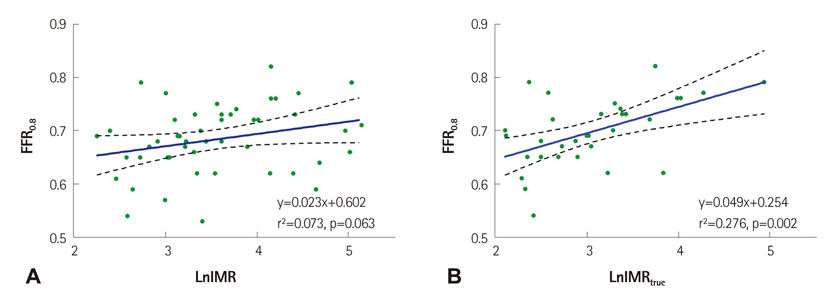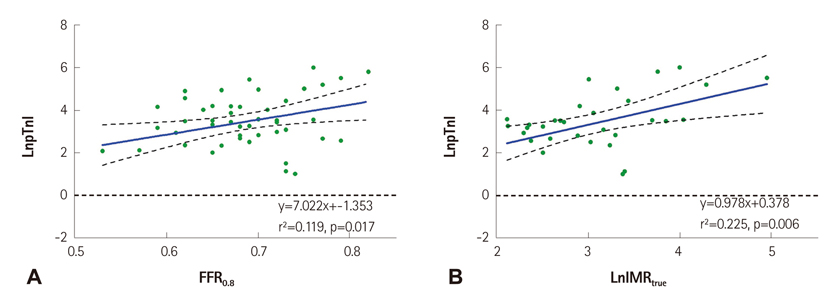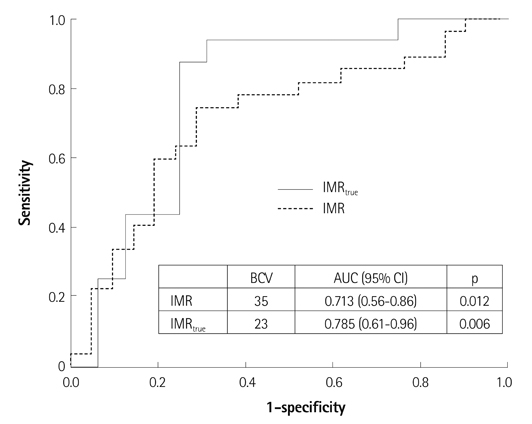Korean Circ J.
2013 Aug;43(8):534-540. 10.4070/kcj.2013.43.8.534.
The Relationship between Microcirculatory Resistance and Fractional Flow Reserve in Patients with Acute Myocardial Infarction
- Affiliations
-
- 1Department of Cardiology, Medical Research Institute, Pusan National University Hospital, Busan, Korea. cks@pusan.ac.kr
- 2Department of Preventive Medicine, Medical Research Institute, Pusan National University Hospital, Busan, Korea.
- KMID: 2224843
- DOI: http://doi.org/10.4070/kcj.2013.43.8.534
Abstract
- BACKGROUND AND OBJECTIVES
It was demonstrated that the fractional flow reserve (FFR) with partial balloon obstruction may have implications for assessing viable myocardium. In a different way, the index of microcirculatory resistance (IMR) was introduced as a useful indicator for assessing microvascular function. We evaluated the relationship between the FFR0.8 and the IMR.
SUBJECTS AND METHODS
We studied 48 consecutive patients who had undergone coronary intervention for acute myocardial infarction (AMI). After revascularization using stent(s), an undersized short balloon was positioned inside the stent and inflated to create a specific normalized pressure drop of FFR (distal coronary/aortic pressure=0.80) at rest. The FFR0.8 was obtained during hyperemia with the fixed state balloon-induced partial obstruction. IMR was measured by three injections of saline. The association between the FFR0.8 and the IMR was investigated.
RESULTS
The mean age of the patients was 60+/-12 years and 36 (75%) overall presented with ST-segment elevation myocardial infarction. The mean FFR0.8 was 0.68+/-0.06. A statistically significant correlation between the FFR0.8 and the log-transformed IMR(true) (LnIMR(true)) was found through a multivariable linear regression analysis (beta=0.056, p<0.001). Both the FFR0.8 and the LnIMR(true) had a positive correlation with the log-transformed peak troponin I (TnI) with statistical significance (r2=0.119, p=0.017; r2=0.225, p=0.006, respectively).
CONCLUSION
There was a positive correlation between the LnIMR(true) and the FFR0.8. Both of the values were associated with peak TnI. Those values may be used as appropriate surrogate measures of microvascular function after AMI.
Keyword
MeSH Terms
Figure
Reference
-
1. Zhang Z, Takarada S, Molloi S. Quantification of coronary microvascular resistance using angiographic images for volumetric blood flow measurement: in vivo validation. Am J Physiol Heart Circ Physiol. 2011; 300:H2096–H2104.2. Kitabata H, Imanishi T, Kubo T, et al. Coronary microvascular resistance index immediately after primary percutaneous coronary intervention as a predictor of the transmural extent of infarction in patients with ST-segment elevation anterior acute myocardial infarction. JACC Cardiovasc Imaging. 2009; 2:263–272.3. Fearon WF, Balsam LB, Farouque HM, et al. Novel index for invasively assessing the coronary microcirculation. Circulation. 2003; 107:3129–3132.4. Fearon WF, Aarnoudse W, Pijls NH, et al. Microvascular resistance is not influenced by epicardial coronary artery stenosis severity: experimental validation. Circulation. 2004; 109:2269–2272.5. McGeoch R, Watkins S, Berry C, et al. The index of microcirculatory resistance measured acutely predicts the extent and severity of myocardial infarction in patients with ST-segment elevation myocardial infarction. JACC Cardiovasc Interv. 2010; 3:715–722.6. Lim HS, Yoon MH, Tahk SJ, et al. Usefulness of the index of microcirculatory resistance for invasively assessing myocardial viability immediately after primary angioplasty for anterior myocardial infarction. Eur Heart J. 2009; 30:2854–2860.7. Kim JH, Park JH, Choo K, et al. Pressure-wire based assessment of microvascular resistance using calibrated upstream balloon obstruction: a predictor of myocardial viability. Catheter Cardiovasc Interv. 2012; 80:581–589.8. Thygesen K, Alpert JS, Jaffe AS, et al. Third universal definition of myocardial infarction. Eur Heart J. 2012; 33:2551–2567.9. Niccoli G, Burzotta F, Galiuto L, Crea F. Myocardial no-reflow in humans. J Am Coll Cardiol. 2009; 54:281–292.10. Bolognese L, Carrabba N, Parodi G, et al. Impact of microvascular dysfunction on left ventricular remodeling and long-term clinical outcome after primary coronary angioplasty for acute myocardial infarction. Circulation. 2004; 109:1121–1126.11. De Bruyne B, Pijls NH, Bartunek J, et al. Fractional flow reserve in patients with prior myocardial infarction. Circulation. 2001; 104:157–162.12. Kocaman SA, Sahinarslan A, Arslan U, Timurkaynak T. The delta fractional flow reserve can predict lesion severity and long-term prognosis. Atherosclerosis. 2009; 203:178–184.13. Aarnoudse W, Fearon WF, Manoharan G, et al. Epicardial stenosis severity does not affect minimal microcirculatory resistance. Circulation. 2004; 110:2137–2142.14. Fearon WF, Shah M, Ng M, et al. Predictive value of the index of microcirculatory resistance in patients with ST-segment elevation myocardial infarction. J Am Coll Cardiol. 2008; 51:560–565.15. De Bruyne B, Pijls NH, Smith L, Wievegg M, Heyndrickx GR. Coronary thermodilution to assess flow reserve: experimental validation. Circulation. 2001; 104:2003–2006.
- Full Text Links
- Actions
-
Cited
- CITED
-
- Close
- Share
- Similar articles
-
- Myocardial fractional flow reserve in acute myocardial infarction
- Physiologic Evaluation of Microvascular Damage in Culprit Vessel After Successful Primary Percutaneous Coronary Intervention for ST-elevation Myocardial Infarction Patients
- Comparison of Myocardial Fractional and Coronary Flow Reserve after Revascularization in Acute Myocardial Infarction
- Clinical Comparison of Coronary Flow Reserve and Fractional Flow Reserve after PTCA in Patients with Coronary Artery Disease
- Hemodynamic Significance of Coronary Cameral Fistula Assessed by Fractional Flow Reserve




